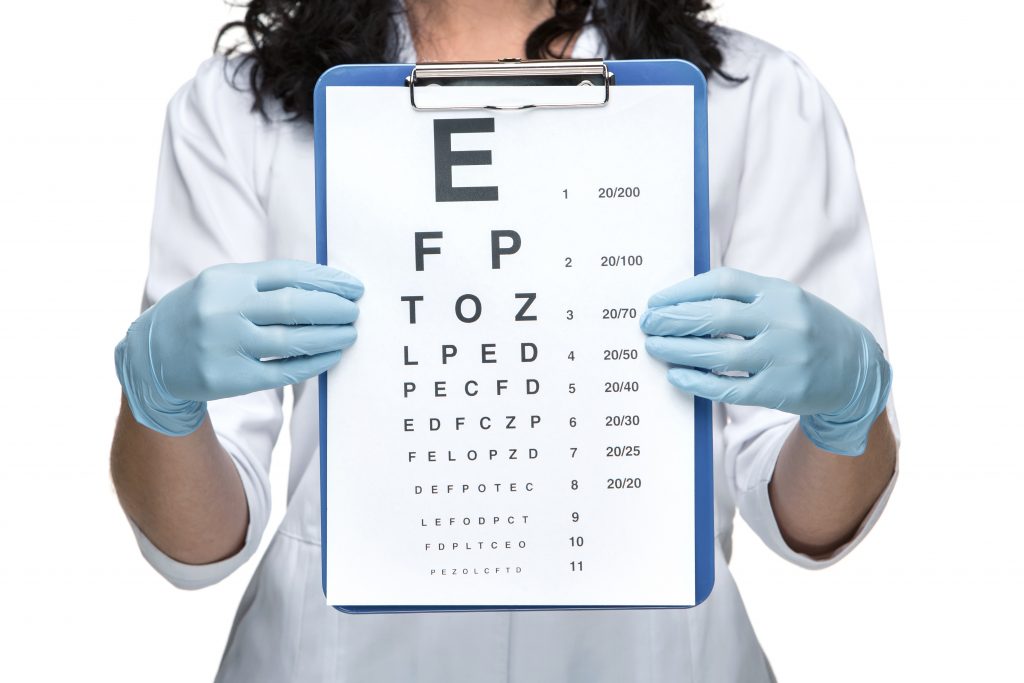Visual acuity
The visual acuity o visus is one of the main abilities of the visual system and is defined as the ability of the eye to perceive and thus resolve even the finest details of observed objects.
It is generally measured by the optician or ophthalmologist to determine the degree of normality of the individual's visus (e.g. 10/10 on Monoyer's table, or 20/20 on Snellen's), in some cases also assessing the sharpness of the image projected onto the retina, using various technical instruments.
During the visual examination, the emergence of lower-than-normal acuity (e.g. 8/10 or eight-tenths) may be a symptom requiring further investigation.
The typical octometric table test (Monoyer, Snellen, etc.), which considers the recognition of alphabetical characters by a particular morphoscopic nature, and which is also used for driving licence renewal (for example), cannot assess maximum visual acuity.
Maximum visual acuity is a measurement that requires specific conditions, and is the inverse of the minimum angular dimensions that an object must have in order to be perceived by the visual system.
The standard visual acuity test
The visual acuity test is a non-invasive examination that is an essential part of the comprehensive eye examination and aims to determine the clarity and sharpness of the view.
These parameters are tested by assessing the ability to distinguish different optotypes (graphic representations of letters or symbols) from a standard distance.
This process, which may seem simple and automatic, actually requires multiple functions on the part of the eye: the retina must be healthy and be able to be reached by light with adequate refraction, and the visual stimuli received must be able to be interpreted correctly by the brain.
A bit of history
The visual acuity test has existed for a long time and as early as 1800, the desire to standardise visual tests led to the creation of different graphs with different octotypes.
The first, and still the most widely used today, is the Snellen table.
More recently, the LogMAR chart (also known as the ETDRS chart) has also become established. For adults, octotypes with letters are usually used, while for children, symbols appropriate to their level of understanding are used.
Currently, there are also many smartphone applications available to carry out the test, which seem to obtain reproducible results.
Visual acuity test results are reported using a scale in tenths or twentieths. The value of 10/10 and 20/20 is what a person with the highest visual acuity gets, but it only represents one aspect of vision and does not include other elements, such as depth perception, peripheral vision and colour blindness.
One of the most common causes of visual impairment are refractive errors, as is the case with myopia and hypermetropia.
Other causes of visual impairment include astigmatism, amblyopia (or 'lazy eye'), retinal detachment, macular degeneration, ischaemia, cataracts, glaucoma, corneal abrasion or other traumatic injuries.
Visual acuity testing is essential in ophthalmological examinations because many of these conditions can be identified early, allowing for early therapeutic intervention.
When the visual acuity test is performed
A visual acuity test is performed as part of a comprehensive eye examination, particularly in these circumstances:
- screening for visual impairment
- support in the diagnosis of relapsing eye diseases
- assessment of acute visual changes, traumatic or non-traumatic
- assessment of vision after corrective surgery
- vision monitoring for driving licence renewal
It plays a role in both the acute and screening context.
In the first case, it is important to document an initial visual acuity score, both for mechanical injuries to the eye and for sudden vision loss (e.g. in the case of glaucoma, retinal detachment or ischaemia).
The visual acuity measured under these circumstances can be compared with the previous test, if available, and will serve as the basis for re-evaluation after surgery in the acute and sub-acute setting.
The visual acuity test from children to adults
Visual screening tests, including visual acuity tests, have numerous advantages in the field of paediatric. In particular, the visual acuity test is the best to detect refractive defects, which are the main cause of visual impairment and reduced vision in children.
During the early stages of development, it is important to subject children to more frequent visual examinations.
In asymptomatic adults, with no significant risk factors
there, a comprehensive eye examination can be performed every 5-10 years under the age of 40, every 2-4 years between the ages of 40 and 54, every 1-3 years between the ages of 55 and 64, and every 1-2 years over the age of 65.
The change in the frequency of check-ups serves to better assess age-related eye diseases.
The visual acuity test in case of pathologies
Individuals at higher risk for glaucoma should have comprehensive eye examinations more frequently, even if they are asymptomatic.
Individuals diagnosed with type 1 diabetes should have an eye examination, including a visual acuity test, five years after diagnosis, and then repeat the examinations annually.
Patients diagnosed with type 2 diabetes, on the other hand, should undergo an annual examination from the time of diagnosis.
In addition, women with diabetes should undergo a comprehensive eye examination, including a visual acuity test, during the first trimester of pregnancy.
The aim of these screening examinations is to enable early intervention to prevent long-term morbidity and improve quality of life.

